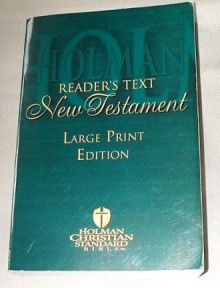Holman Christian Standard Bible
From Textus Receptus
| Holman Christian Standard Bible | |
|---|---|
|
}} | |
| Full name: | Holman Christian Standard Bible |
| Other names: | {{{other_names}}}
}} |
| Abbreviation: | HCSB
}} |
| Language: | {{{language}}}
}} |
| NT published: | [[{{{NT_published}}}]]
}} |
| OT published: | [[{{{OT_published}}}]]
}} |
| Complete Bible published: | 2004
}} |
| Apocrypha books: | {{{apocrypha_books}}}
}} |
| Author(s): | {{{author_info}}}
}} |
| Derived from: | {{{derived_from}}}
}} |
| Textual Basis: | NT: Novum Testamentum Graece 27th edition. OT: Biblia Hebraica Stuttgartensia with some Septuagint influence.
}} |
| Translation type: | Dynamic and Formal Equivalence<ref>http://www.wordsearchbible.com/products/Holman_Christian_Standard_Bible_780.html wordsearchbible.com - Holman Christian Standard Bible (HCSB)</ref><ref>http://www.bible-researcher.com/csb-intro.html bible-researcher.com - Introduction to the Holman Christian Standard Bible</ref>
}} |
| Reading Level: | Middle School
}} |
| Version Revised: | {{{version_revised}}}
}} |
| Publisher: | {{{publisher}}}
}} |
| Copyright status: | Copyright 2004 Holman Bible Publishers
}} |
| Copies Printed: | {{{copies_printed}}}
}} |
| Religious Affiliation: | {{{religious_affiliation}}}
}} |
| Online address: | {{{online_address}}}
}} |
| In the beginning God created the heavens and the earth. Now the earth was formless and empty, darkness covered the surface of the watery depths, and the Spirit of God was hovering over the surface of the waters. Then God said, "Let there be light," and there was light. | |
| For God loved the world in this way: He gave His One and Only Son, so that everyone who believes in Him might not perish but have eternal life. | |
| Template:Tnavbar | |
The Holman Christian Standard Bible is an English translation of the Bible, published by Holman Bible Publishers. The first full edition was completed in March 2004, with the New Testament alone having been previously published in 1999.
Contents |
Beginnings
The roots of the HCSB can be traced back as early as 1984, when Arthur Farstad, general editor of the New King James Version of the Bible, began a new independent translation project. In 1998, Farstad and LifeWay Christian Resources (the publishing arm of the Southern Baptist Convention) came to an agreement that would allow LifeWay to fund and publish the completed work. Farstad died shortly thereafter, and leadership of the editorial team was turned over to Dr. Edwin Blum, who had been an integral part of the team. Interestingly, the death of Farstad resulted in a change in the Greek New Testament text underlying the HCSB; although Farstad had envisioned basing the new translation on the same texts used for the original King James Version and New King James Version, after Farstad's death, the editorial team replaced this text with the Greek New Testament as established by modern scholars (Dewey 2004). This is the editions of the United Bible Societies and of Nestle-Aland.
Translation Philosophy
Holman Bible Publishers assembled an international, interdenominational team of 100 scholars and proofreaders, all of whom were committed to biblical inerrancy.<ref> "The Bible is God's revelation to man ... it is God's inspired Word, inerrant in the original manuscripts." From 'Introduction' to the HCSB. Text of the 'Introduction' also at BibleGateway.com.</ref> The translation committee sought to strike a balance between the two prevailing philosophies of Bible translation: formal equivalence (literal, "word-for-word", etc) and dynamic or functional equivalence ("thought-for-thought"). The translators call this balance Optimal Equivalence.
According to the translators, the primary goal of optimal equivalence translations is "to convey a sense of the original text with as much clarity as possible". To that end, the ancient source texts were exhaustively scrutinized at every level (word, phrase, clause, sentence, discourse) to determine its original meaning and intention. Afterwards, using the best language tools available, the semantic and linguistic equivalents were translated into as readable a text as possible.
Textual Basis
Making use of the most recent scholarly traditions, the translators worked from the Nestle-Aland Novum Testamentum Graece, 27th edition, and the United Bible Societies' Greek New Testament, 4th corrected edition (for the New Testament), and the 5th edition of the Biblia Hebraica Stuttgartensia (for the Old Testament).
In the case of significant differences among Hebrew and Aramaic manuscripts of the OT or among Greek manuscripts of the NT, the translators followed what they believed was the original reading and indicated the main alternative(s) in footnotes. There are a few places in the NT that the translation team and most biblical scholars today believe were not part of the original text. However, these texts were retained (and indicated in large square brackets) because of their undeniable antiquity and their value for tradition and the history of NT interpretation in the church.
References
| references-column-width
| references-column-count references-column-count-{{{1}}} }}
| {{#if:
| references-column-width }} }}" style="{{#if:
| {{#iferror: {{#ifexpr: 1 > 1 }}
| column-width: {{{1}}}; -moz-column-width: {{{1}}}; -webkit-column-width: {{{1}}};
| column-count: {{{1}}}; -moz-column-count: {{{1}}}; -webkit-column-count: {{{1}}}; }}
| {{#if:
| column-width: {{{colwidth}}}; -moz-column-width: {{{colwidth}}}; -webkit-column-width: {{{colwidth}}}; }} }}">
Unknown extension tag "references"Sources
- Marlowe, Michael D. (2004) "Holman Christian Standard Bible". Retrieved March 14, 2005.
- Holman Bible Publishers. (2004) "Introduction to the Holman Christian Standard Bible". Retrieved March 14, 2005.
- Perry, John. (May 7, 1999) "Broadman & Holman Publishers announces new Bible translation". Retrieved March 14, 2005.
- Walker, Ken. (July 20, 2001) "Holman Christian Standard Bible New Testament now available". Retrieved March 14, 2005.
- LifeWay Christian Resources. "The Holman CSB Translation Philosophy". Retrieved March 14, 2005.
- Dewey, David, 2004. A User's Guide to Bible Translations (Downers Grove, IL: Intervarsity Press, 2004). ISBN 0-8308-3273-4.
- Cheung, Andy. (Jan 24, 2008) "Brief Thoughts on the Holman Christian Standard Bible" Retrieved Jan 24, 2008. Review article from the Midlands Bible College

